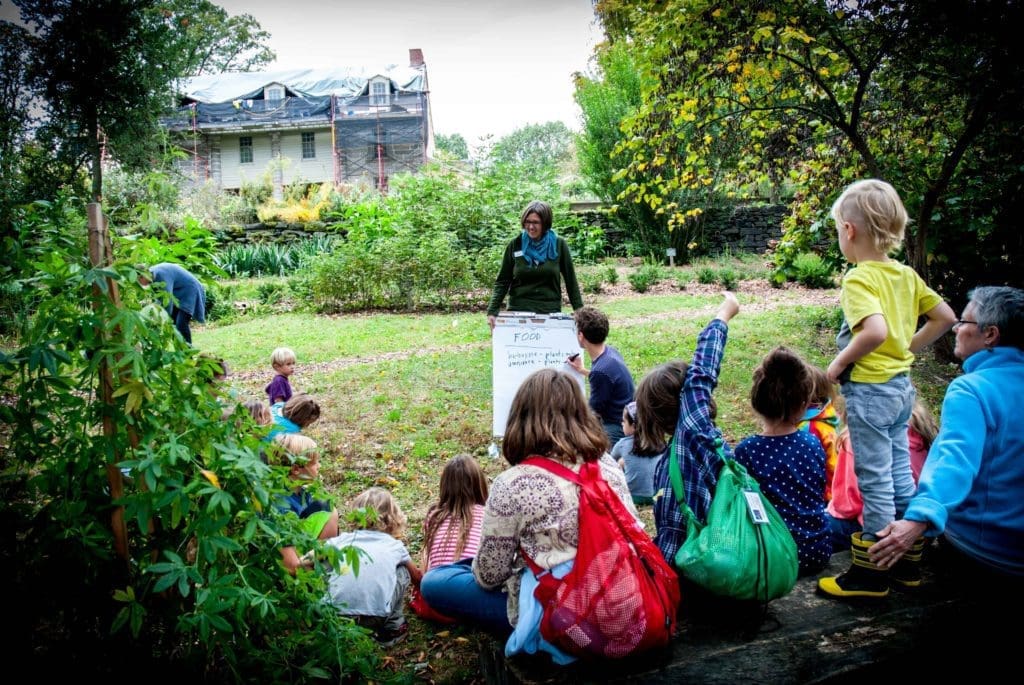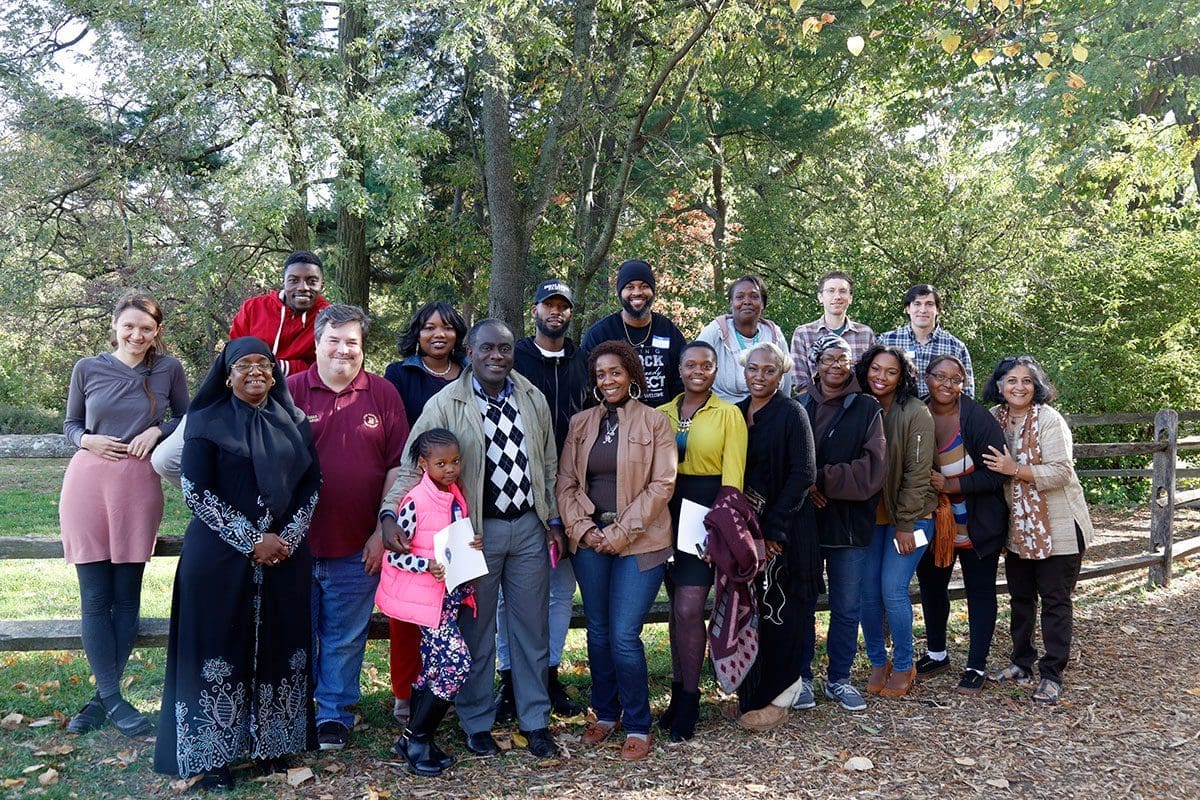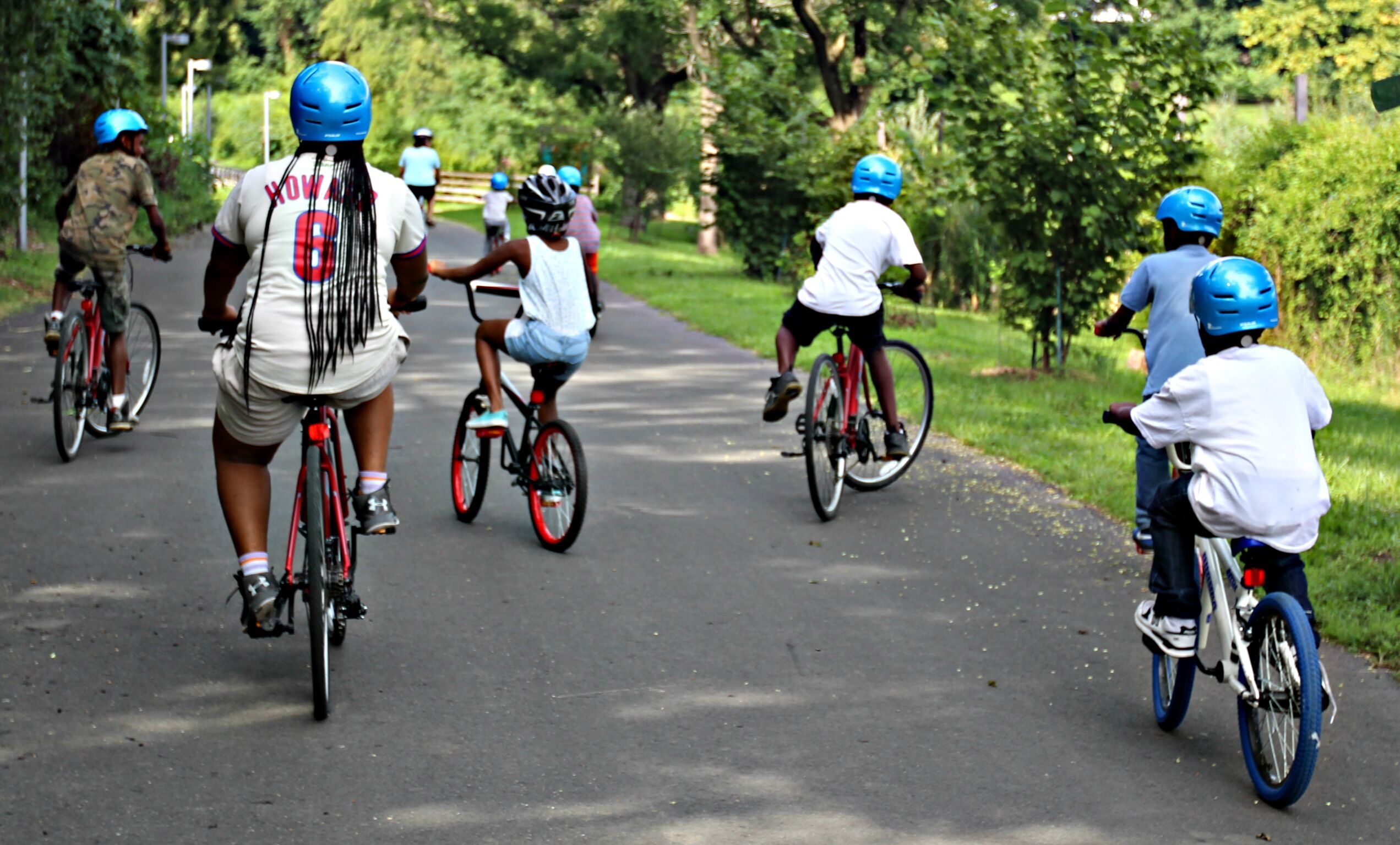My backyard is Bartram’s Garden!

By Staci Vernick
These words may be Bartram’s latest marketing slogan, popping up on lawn signs all over Philadelphia, but their meaning is anything but new. Growing the garden as a welcoming community, and reaching out to engage its neighbors – both locally in Southwest Philadelphia, and across the region – has been a priority at Bartram’s Garden for the last six years.
That focus has had an impact, leading to more visitors, greater engagement and improved perceptions of the Garden among its neighbors, near and far. These are among the findings in a new report from a Penn State research team following a 2017 survey of garden visitors and Southwest Philadelphia residents. The study was commissioned by the William Penn Foundation to assess changes following investments in “Reimagining the Civic Commons”, including Bartram’s Mile improvements, as well as the newly opened Rail Park in Callowhill and development of the Centennial Commons in West Fairmount Park. The Civic Commons project explores how public spaces shape the social fabric of urban neighborhoods and enhance quality of life.
“Reaching out to share the magic that is Bartram’s Garden with others is what drives us every single day,” said Executive Director Maitreyi Roy. “We want people to feel welcome, like you do in a friend’s backyard. This study shows we are on the right track, and also that we have room to improve. This is gratifying to know, and also energizing as we continue to grow Bartram’s into an exceptional experience for all.”

The researchers’ central question: how have visitor and area resident usage and perceptions of the Garden, and its role in the neighborhood, changed since major renovations of Bartram’s Garden and Bartram’s Mile? From the Foundation’s perspective, can targeted investments bridge perceived differences between groups of people and reduce economic and social divisions?
To get at the answers, researchers took a two-pronged approach, looking not only at visitors to Bartram’s, but also reaching into the surrounding neighborhood, those areas for which Bartram’s is, almost literally, their backyard.
Dividing Bartram’s Garden and Mile into seven zones and, using established protocols for observing and counting people and activities in outdoor spaces, surveyors gathered data that represents a snapshot of a typical week at the garden – who visits Bartram’s, when do they visit, what do they like to do here, and why?
The study team also engaged visitors in completing brief, iPad-based questionnaires to gather demographic data. More than half of those visitors who were approached completed the survey, which helped shape an accurate visitor profile.
The on-site observations showed an average weekly count of 2,715 visitors during peak season, which roughly translates to 95,000 visitors a year, a happy surprise to Bartram’s Garden staff.

“Visitation is the biggest headline from this study,” said Bartram’s Director of Development Caroline Winschel. “It’s very hard to get accurate visitor counts here, where we are so widespread with so many ways to come and go. Anecdotally, we’d been estimating 55,000 visitors a year. 95,000 is significantly more than we imagined, and it’s incredibly valuable information to help us plan for the future.”
The visitor surveys showed that 59 percent of visitors were from Philadelphia (26 percent from neighboring Southwest) and half of them have been to Bartram’s before; almost 50 percent came to the garden to experience nature, and they spend time in the boating area, strolling through the ornamental gardens and along the Mile; visitor ethnicity is a fairly balanced mix of 48 percent African American, 52 percent white, Latino or other; more than half of visitors are adults (39 percent of whom visit with children) and the slim majority (60 percent) are women. Bartram’s Garden staff were especially gratified to note the high numbers of non-white visitors, which is not typical for most public space studies and which reflects the Garden’s recent outreach in the Southwest Philadelphia community.

The surveyors also asked questions designed to gauge a visitor’s sense of belonging, feeling of welcome, and sense that they matter to Bartram’s Garden. Results were overwhelmingly positive, with 87 percent of visitors agreeing that they feel welcome, like they belong, and that Bartram’s is a “comfortable place to hang out.” Surveyors found a high degree of social integration, or socio-economic mixing, with 62 percent of visitors reporting they greet and/or interact with people from different backgrounds.
“I’ve been coming to Bartram’s for two years …and the Bartram’s Mile expansion has dramatically changed where I can walk with my daughter in a wheelchair,” said a female West Philadelphia resident in response to a surveyor’s question. “We used to come to walk just to enjoy nature, and have some stress relief and solitude, and now we can actually walk around … and that is a huge benefit to us.”

To dig deeper into neighbors’ perceptions about Bartram’s, members of Penn State’s Survey Research Center hired and trained a small group of local residents as data collection specialists who went door-to-door, speaking with about 300 residents of Bartram Village and the nearby neighborhood bound by 58th Street, Grays Avenue and Lindbergh Boulevard.
They found more than 80 percent of neighbors had visited Bartram’s in the past, half of them within the last year. In general, their perceptions of the quality of their Bartram’s experience echoed those reported in the on-site visitor surveys. But their feelings of welcome and belonging were much higher: 95 percent of neighbors said they feel welcome at Bartram’s and 87 percent feel like they belong and matter. Social integration measures were greater, too, with 83 percent of neighbors greeting and interacting with people of different backgrounds.
Other measures gauged Bartram’s value as part of the “social fabric” of the neighborhood. Ninety-two percent of residents agreed that Bartram’s Garden is “a very important part of this neighborhood” and the garden “benefits the local neighborhood.” The results also suggest that since the recent renovations and improvements, Bartram’s seems to be a happening place, with more people visiting, more programs and events to attract people, and a cleaner, more inviting space overall.

The team also convened focus groups representing about 20 neighbor households to gain an even deeper understanding of opinions about Bartram’s and their own evolving neighborhood. Overall, the results were positive and encouraging, similar to the earlier feedback about civic engagement and a sense of excitement and belonging. Some residents expressed concerns, however, about the gentrification that sometimes accompanies major urban renewal. Others reported a sense of simply not knowing Bartram’s Garden was a public, accessible space, pointing to new opportunities for Bartram’s to reach out and engage the community.
“The key take-away for me is knowing that we are firmly on the right path, that we are making the right improvements to the land and buildings, developing programs and events valued by our community partners, and bringing our neighbors right along with us in the process,” Roy said. “We have identified some areas for improvement and now have valuable data to help us plan for the future. And isn’t that what a garden is all about?”


